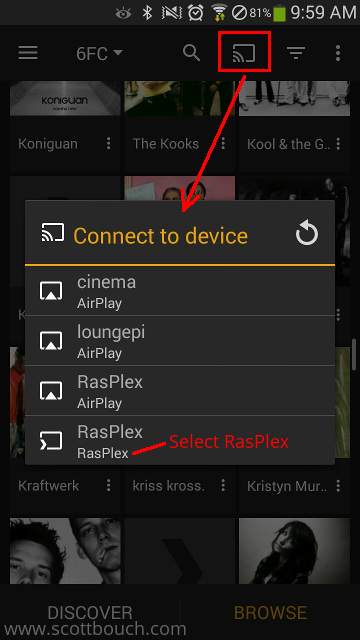

- #PLEX MEDIA PLAYER RASPBERRY PI SOUND OUT OF AUX HOW TO#
- #PLEX MEDIA PLAYER RASPBERRY PI SOUND OUT OF AUX INSTALL#
- #PLEX MEDIA PLAYER RASPBERRY PI SOUND OUT OF AUX FULL#
There are many command-line options that allow you to control how the audio is played. It sends audio to the analogue audio jack by default, so playing back an MP3 file is as simple as running: omxplayer /path/to/audio/file.wav
#PLEX MEDIA PLAYER RASPBERRY PI SOUND OUT OF AUX FULL#
This is a dedicated hardware-accelerated command-line tool that takes full advantage of Raspberry Pi’s capabilities. The simplest way to play audio on Raspbian is to use OMXPlayer. As they are low-power, USB devices do not tend to feature amplification, unless they have a separate power source. Unsurprisingly, when choosing your USB sound device, you can start at a few pounds and go right up to professional equipment costing hundreds. Many DACs also come with on-board amplifiers. To fix this, run alsamixer from the command line, press F6 to select the new sound device, and if you see ‘MM’ at the bottom of the volume indicator, press M to unmute and adjust the volume with the cursor keys. You may need to select the new output, as the underlying audio system, ALSA (see the ALSA and PulseAudio section for more), may mute it by default. Installation tends to be no more complicated than plugging the device into the USB port. Literally hundreds are available, and a basic input/output device with better audio quality than the on-board system can be purchased for a few pounds online. Plug and playbackĪ USB sound device is another simple choice for audio playback on Raspberry Pi.

You may need to reboot Raspbian for all changes to take effect. When the menu appears, go to Advanced Options and select Audio, then select the option to force the output through the audio jack. To fix this, open up a terminal window and run sudo raspi-config. an HDMI TV), sound will not come out of the correct device. Sometimes, especially if you’ve connected an HDMI monitor with sound capability (e.g. Normally, the Raspbian operating system will recognise that an audio device has been connected and route audio through it. Need a simple solution? USB audio devices come in all shapes and sizes but are mostly plug-and-play
#PLEX MEDIA PLAYER RASPBERRY PI SOUND OUT OF AUX HOW TO#
This is the most direct way of adding sound to your project, but how to get the sound out? Of course, add an amplifier or active speaker and you have sound as loud as you like. This provides your cheapest route to getting audio from your Raspberry Pi computer.Ī low-cost passive speaker can be directly plugged in to provide sound, albeit probably quieter than you’d like. The original Raspberry Pi featured a stereo 3.5mm socket, and all A and B models since feature a four-pole socket that also includes composite video. Raspberry Pi computers, with the exception of the Zero range, all have audio output on board. See if you can make Morse code sounds by changing the duration of the sleep statement. Run it at the command line: python3 buzz.py
#PLEX MEDIA PLAYER RASPBERRY PI SOUND OUT OF AUX INSTALL#
Now, install the GPIO Zero Python library by typing this at the command line: sudo apt install python3-gpiozeroĬreate a file called buzz.py in your favourite editor and enter the following: import time Try connecting a buzzer’s red wire (positive) to GPIO pin 22 (Broadcom numbering) and the black wire (ground) to any GND pin. A cheap active buzzer can be quickly added to Raspberry Pi’s GPIO.

The simplest place to start is with the humble buzzer. Need to keep it simple and under a pound?


 0 kommentar(er)
0 kommentar(er)
